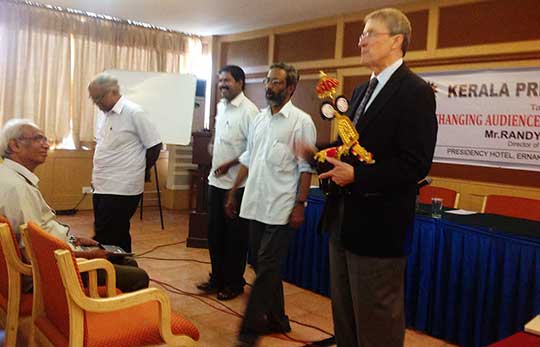Print media should change to survive: Randy Covington

“With 65 per cent of the population under the age of 35 and the youth going digital, can newspapers in India avoid getting into the death spiral?” asked Randy Covington, Director of the WAN-IFRA Newsplex Training Centre at the University of South Carolina. He was speaking at a seminar titled ‘Changing audience - changing newsrooms’ organised by Kerala Press Academy here on Saturday.
Mr. Randy said that Indian newspapers were at present not in a spot of bother with circulation increasing and internet penetration in the country passing only 10 per cent. However, newspapers should not become complacent and wait for a flashpoint as change in India will happen more quickly than many realise.
“One out of six cell phone users worldwide are in India. With mobile phone operators aggressively marketing smartphones and tablets, newspapers need to manage change, learn new ways of telling stories and replenish older readers with younger ones,” he said. According to him, it is time to develop the strategy. If newspapers refuse to adopt new technology and target the youth who want to get want they want, when they want it and as much as they want it, then newspapers are fighting a losing battle. “Newspapers will be best served if they focus on stories. Newsrooms should not only be designed to facilitate a production process, but should be able to design a story.”
Rather than focussing on how many inches or a how long a story should run, print journalists need to embrace interesting ways to tell a story. “The goal is to deconstruct the story so that it is easy for the public to consume,” Mr. Randy said.
Newspapers need to employ diagrams, polls and surveys, briefings, first person accounts, Q’s and A’s, timelines, pros and cons, vignettes, quizzes, charts and grids to tell stories.

Mr. Randy felt that it was time newspapers went digital and had an interactive online version. “If newspapers do not go online then they run the risk of losing a sizeable audience when others go online. Most of the online websites are sucking the blood out of traditional news organisations,” he said.
Newspapers can use online resources which are interactive, easy to use, very effective and come free of cost. Google maps according to him was the perfect example.
“Journalists can collect the addresses of eye-witnesses of an incident and make pins on a google map. By clicking each pin, readers can read a quote, watch a video or see pictures related to the incident. Every pin becomes a newspaper,” he said.
Online websites of newspapers should become ‘TV for smart people’. Print journalists should carry along iphones or flip cameras while covering an event. They can shoot videos, stream interviews, and use still pictures to make a slideshow on the website. Mr. Randy felt that newspapers should put breaking stories on the website first. This would help stave off the challenge posed by television.
Mr. Randy admitted that latest technology and high speed access could pave way for misleading and vulgar content going viral.
“Newspapers need to practice professionalism and ensure that the content put up on the website is accurate and credible,” he said.
However, he said, there was no denying that an interactive online version would prevent a newspaper from becoming a bare-bones product when circulation and advertising revenues drop.
“Do not wait for newspapers to die and revenue to fall off the cliff. Do not make the same mistake that newspapers in Europe and U.S. made. We were too slow to change.”
N.P.Rajendran, chairman of the academy welcomed the gathering. M. Ramachandran, director of Institute of communications presented a memento to Randy on behalf of the academy.
(Photo and most of the content from The Hindu dated 18 Aug 2012)